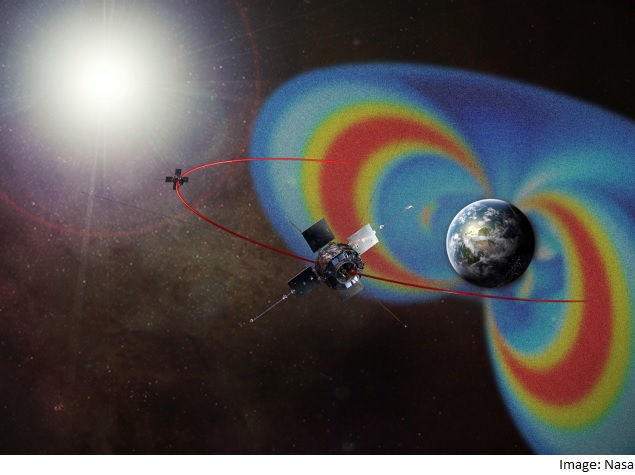- Home
- Science
- Science News
- 'Destructive Electrons Streaking Into Earth's Atmosphere at Near Light Speed'
'Destructive Electrons Streaking Into Earth's Atmosphere at Near Light Speed'

Researchers have now launched a project in Antarctica to record X-rays produced as falling electrons collide with the Earth's atmosphere. Particle onslaught can lead to ozone depletion and damage to the orbital satellites that provide us with the navigation, communication, weather and military-recognisance information upon which we have become dependent, researchers said.
These satellites fly through the Van Allen radiation belts - giant concentric layers of charged particles held in place by the Earth's magnetic field.
An increase in particle density and charge brought about by solar activity can raise the level of threat to our critical satellites. Scientists engaged in a unique study of this electronic bombardment, for the first time employing two distinctly different and distant vantage points high above the Earth.
"This is exciting for us because we are integrating data collected by our instruments with the data from Nasa's Van Allen Probes," said Robyn Millan, an associate professor of physics and astronomy at the Dartmouth College in US. Millan uses instruments carried aloft by balloons launched from Antarctica, rising as high as 125,000 feet.
Supported by Nasa, the project is called BARREL, an acronym for Balloon Array for Radiation belt Relativistic Electron Losses. The instruments record the X-rays produced as the falling electrons collide with the atmosphere.
The second source of information, also a Nasa project, comprises the two Van Allen Probe satellites launched in 2012. The probes circle the Earth in eccentric orbits around the equator at altitudes of up to 32,000 kilometres. "Our paper looked at plasma waves," said Millan.
"These are like sound waves in air except that now you are in an ionised gas so the electric and magnetic fields are affected," she said.
Millan describes a solar flare that occurred in January 2014, releasing a burst of solar wind particles that hit and disturbed Earth's magnetic field. That created a particular kind of wave called "plasmaspheric hiss," examples of which have been observed for decades in the dense plasma region that encircles the Earth in the upper reaches of the atmosphere.
"What the paper shows is that we observed these waves at the location of the Van Allen probes. We saw electric and magnetic field variations that displayed a pattern, matching the variations in the X-rays we were recording in Antarctica," Millan said.
"We concluded that those waves were causing the electrons to be scattered, yielding a new understanding of how the particles are getting kicked into the atmosphere," she said.
The study was published in the journal Nature.
Catch the latest from the Consumer Electronics Show on Gadgets 360, at our CES 2026 hub.
Related Stories
- Samsung Galaxy Unpacked 2025
- ChatGPT
- Redmi Note 14 Pro+
- iPhone 16
- Apple Vision Pro
- Oneplus 12
- OnePlus Nord CE 3 Lite 5G
- iPhone 13
- Xiaomi 14 Pro
- Oppo Find N3
- Tecno Spark Go (2023)
- Realme V30
- Best Phones Under 25000
- Samsung Galaxy S24 Series
- Cryptocurrency
- iQoo 12
- Samsung Galaxy S24 Ultra
- Giottus
- Samsung Galaxy Z Flip 5
- Apple 'Scary Fast'
- Housefull 5
- GoPro Hero 12 Black Review
- Invincible Season 2
- JioGlass
- HD Ready TV
- Laptop Under 50000
- Smartwatch Under 10000
- Latest Mobile Phones
- Compare Phones
- Honor Win RT
- Honor Win
- Xiaomi 17 Ultra Leica Edition
- Xiaomi 17 Ultra
- Huawei Nova 15
- Huawei Nova 15 Pro
- Huawei Nova 15 Ultra
- OnePlus 15R
- Asus ProArt P16
- MacBook Pro 14-inch (M5, 2025)
- OPPO Pad Air 5
- Huawei MatePad 11.5 (2026)
- Xiaomi Watch 5
- Huawei Watch 10th Anniversary Edition
- Acerpure Nitro Z Series 100-inch QLED TV
- Samsung 43 Inch LED Ultra HD (4K) Smart TV (UA43UE81AFULXL)
- Asus ROG Ally
- Nintendo Switch Lite
- Haier 1.6 Ton 5 Star Inverter Split AC (HSU19G-MZAID5BN-INV)
- Haier 1.6 Ton 5 Star Inverter Split AC (HSU19G-MZAIM5BN-INV)

















